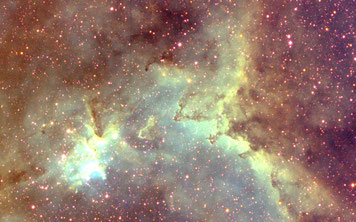Gallery · 09. January 2018
The Heart Nebula, like most emission nebulas, is inflated like a bubble by newborn stars in its interior.
Gallery · 16. December 2017
Narrow-band image of the Heart Nebula, IC 1805. Only 110 minutes exposure through Ha, OIII, and SII Chroma filters.
Gallery · 13. November 2017
This image consists of only two hours of integration time, including twenty minutes of luminosity. These are far too short integration times for narrow-band sub-exposures. That is why this image is very noisy, - with distinct graininess at full resolution.
Gallery · 03. September 2017
During the acquisition of this image, sunspot AR2673 (below and to right of centre) was growing to more than ten times its original size during the course of only 24 hours.
Gallery · 18. February 2017
The ASA DDM 160 mount, controlled by Autoslew, was tracking on the comet for ten minutes. The monochrome Apogee U16M camera made two minute exposures five times consecutively through red, green, blue and luminance filters.
Gallery · 14. February 2017
Twenty-five thousand light-years distant and 150 light-years in diameter, Messier 13 is one of the brightest globular star clusters in the northern sky.
Gallery · 25. September 2016
Three hours before twenty guests arrive at a dinner party at a Corsican winery, one should not agree to clean and collimate the host's dusty, dilapidated 8 inch Newtonian, in order to show twenty curious guests some exciting celestial objects.
Gallery · 14. September 2016
An extensive study published in 1996 in Astronomy and Astrophysics concluded that the entire mass of IC 1396 is around 12,000 solar masses.
Gallery · 10. September 2016
NGC 7000 is an emission nebula, meaning that its gaseous hydrogen, oxygen and sulphur are strongly irradiated by ultraviolet light from a nearby star.
Gallery · 15. May 2016
A sunspot group that resembled a flattened smiley face was located in the southern hemisphere one week ago, during the Mercury transit. Amazingly, a new group in the northern hemisphere looks similar, at least superficially, with pattern recognition in high gear :-)










